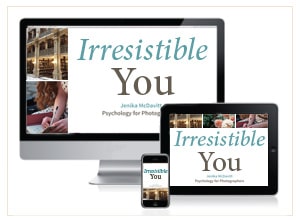The Blog Library
An Easy Way To Get Out Of Three Uncomfortable Sales Situations
When you make the leap from “doing something you love” over to “selling something,” you quickly find yourself in uncomfortable situations.
When you were taking photos for the fun of it, you could easily walk up to someone and say “hey, can I take your picture?”
But feels completely different to say “Hey, can you pay me to take your picture?”
You know how to handle the first situation – just being friendly and personable. But this other one? Eeeechhhhgghhh. It violates all kinds of social rules we have about not asking for things, not acting like you’re so great, not putting people on the spot – and more.
Navigating a new world outside the social rules you’re used to feels hard.
The thing no one tells you is:
The rules aren’t nearly as different as you think. You can and should keep being personable – especially if you’re a small business, where one of the greatest assets you have is the personal touch.
Lots of people retreat into using super formal business language to sell, thinking it’s “more professional.” It feels safer at first, because if you’re acting ‘businessy’ it doesn’t break any social rules.
But then when no one responds, and you look at your work and don’t see yourself in it, it’s dispiriting.
Making uncomfortable sales situations disappear is usually a matter of mindfully adding your personality back in.
Here are three examples that show what I mean:
1) You need to sell some sessions, but freeze as you write up some blog or Facebook copy, because you hate feeling like you’re “begging” for work.
First, let’s reframe this: You’re not asking them to buy something. You’re letting them know that you have something that they need.
Totally different thing, isn’t it?
We hate feeling like we’re selling because socially, that’s dicey ground. But we usually don’t have any problem saying “Oh – so you need this. Guess what, I can make it happen!” We feel okay with helping someone reach a goal.
Here’s how you can make that feel more natural – tell us a little about how YOU need the thing you’re selling too.
Why not post something like:
“This is the time of year I start thinking man, what am I going to do about Christmas cards? Am I already behind? And then someone yelps in the background and shatters my train of thought.
If you find yourself in the same spot of pushing something off you want to do, let me help. Drop your email below and I’ll send you a quick personal email (bullet points are a mom’s best friend!) with the essentials, and we’ll make it happen. Don’t worry, I won’t bug you – but let’s take care of this so you can get back to your afternoon.”
Most of the personal conversations we have revolve around sharing little tidbits like this. You post on Facebook “crazy day here – my kids are bouncing off the walls!” and other parents comment “yeah, me too!” or “let me know if you need anything, I’ve been there.”
There’s no reason why your business can’t have the same empathy for people. “Oh, you need Christmas cards and don’t have time? Been there. Here’s my service, and here’s how I can make it easier for you. Come on over.” Then you let them give you a list of already-interested sales leads.
Most people prefer to do business with people they know and like. Keep being personable and it makes it easier for them.
2) Someone emails that they’re unhappy with part of their order.
Eeeek this is one that feels the worst. Most people shy away from confrontation in real life, and navigating conflict in business can feel like a social hot mess.
Of course, when you set up your business, it’s important to set clear policies (written into your contracts) of exactly how you’ll handle different kinds of issues.
But as you reply, instead of only pivoting to the policy (which might make them even more angry), take a minute to relate to them the way you’d relate to a friend who was frustrated:
“Hey Jane – Thanks for letting me know! I’m so sorry to hear that you were disappointed. I definitely don’t like it when something isn’t how I hoped and expected it to be, so let’s get this fixed. Here are two things we can do:”
Then you state what your policies allow for.
Just taking that second to share how you’d feel if you were in their shoes – which you’d do if a friend – will more than likely change their response.
This isn’t about bowing to their demands, it’s about showing empathy for their half of the situation.
A major reason people are often critical, mean, and angry when talking online is that we are stripped of social context that usually causes people to rein it in.
You’re less likely to get angry at someone who has an empathetic look on their face, who you know is similar to you in some way.
Acknowledging how you’d feel if you were in their shoes helps restore that sense of similarity, helps them see that you’re “on the same team” which automatically makes them more likely to work with you.
3) You want to email a past client to get them to schedule another session – but don’t know how to drop in out of the blue and tell them “hey – book me!”
Again, if you think of this as banging down someone’s door and saying “give me money,” sure – it’s awkward.
But think about the reframe we did in #1 – what is it they need? Most people like having updated photos every year. (If you’re a graphic designer, most people need an annual tune-up as things change. Few creative services are one-and-done.)
Most people don’t have the bandwidth to seek someone out every time to fill every need they have – some things get left un-done out of sheer inconvenience.
So again, much like in the examples above, all you have to do is start out like you’re emailing any friend. This time, a friend you haven’t talked to in awhile. Then mention a possible problem they might have and what you can do for them:
“Hey Jodi! I was just thinking about you today. How is John? How’s Sarah? How did her science competition go? This past summer I went to Yellowstone and one of the gift shops had a bunch of natural science stuff for kids – it made me smile and think of her.
I would love to work with you guys again, and who knows – maybe you were thinking it was time for an update to your Christmas card files, too! I have three spots open next month – want me to save one of them for you?”
Past clients are a good spot to start when you’re looking to fill your calendar.
(By the way: Marketing Metrics found that you’re 60-70% likely to sell to an existing customer, but only 5-20% likely to sell to someone entirely new. And 61% of small to medium-sized businesses report that over half their revenue comes from repeat customers.)
Simply dropping by, greeting them the way you would any friend, and asking if they need X because you know they Y and Z, is a much lower stress way to approach things. It also feels better than trying to make a long list of reasons to hire you again.
Business feels a lot easier when you give yourself permission to bring your own personality back in.
It’s faster to write marketing pieces, blog posts, and emails, because you’re talking more like you usually talk.
Clients like it more, because they feel the pull of similarity and empathy.
And there are all kinds of psychological influences working behind the scenes in your favor. We haven’t even scratched the surface of them.
In fact, just this week, I’ve released an entire course on how (and why!) to breathe your personality back into your business.
There are so many tools to take advantage of that I can’t cover thoroughly on the blog, so I created a course to take you through start to finish. This class gives you dozens of ways to persuade and captivate, no matter who you are or where you’re starting from.
 This class is for you if you’ve ever tried to write about yourself and said:
This class is for you if you’ve ever tried to write about yourself and said:
I don’t know what people want to hear!
I’ve tried, but just feel like I’m bragging!
My life is just not that interesting.
I’m a private person / introvert, I don’t want to share much.
Whenever I go to write about myself, it comes out sounding dumb.
I don’t know how to sound like ME.
Writing about yourself in business does not have to be hard or mysterious. Most people simply never learned how to write about themselves (or were actively discouraged from doing so), and we can fix that.
 In this class you’ll learn:
In this class you’ll learn:
- What clients actually want to hear about you, personally
- Five psychological influences that make personal sharing smart business strategy
- How to talk about yourself without feeling self-absorbed or boastful
- How to pick stories that will draw your ideal clients in
- The “it girl” secrets to dominating online (that even an introvert can steal)
- How to sound like yourself when you write
- Two secret tricks to being memorable – no matter your personality
- How to find the right balance of personal and professional for your situation
- The Never-Ending Content Generator strategy for never running out of ways to connect with your reader (seriously – you’ll have a year’s worth of blog posts in no time)
You’ll also get an exclusive invitation to our live annual virtual retreat.
Where you can ask questions that arise as you put these skills into practice, plus see how other people are making the ideas work for them.
It’s kind of like a conference, but the kind where you get to sit at home in your comfy pants. I might make admission contingent on you having a nice mug of tea at your desk, though. Might. 😉
Irresistible You can be yours for only $219.
(Community college classes run you $500 or more – learn exactly what you need sitting at home instead!)
Have questions about whether it’s right for you?
Totally been there! Feel free to email me at jenika@psychologyforphotographers.com. I’m not here to talk you into or out of anything, but I’m happy to offer insight and help you weigh your options.
Check out Irresistible You now!






Thank you for all of your help and inspiration. I’ve gained so much confidence. I sincerely appreciate it.
Remember there is a solution to every problem you just have to solve it slowly and think it wisely.